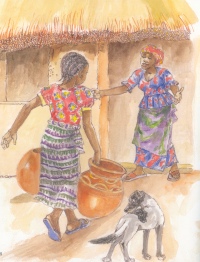| ________________
CM . . . . Volume XVIII Number 32 . . . . April 20, 2012
excerpt:
Akosua’s Gift tells of a time many years ago when the women of the Ashanti village of Tafo in Ghana made all of their pots from clay. The finished pots had many uses, from cooking to storage, including being used for carrying water and keeping it cool. This functional craft was one that was passed on from mother to daughter, and Akosua, the youngest daughter in a family of skilled pot makers, has been steadily improving in her technique. When it is announced that Abena, Akosua’s senior sister, is to be married, Akosua decides that she will take a risk by secretly attempting something new. “Until now, I have only made small cooking pots. Could I possibly make a larger pot for Abena to carry and to store fresh spring water?”
When Akosua’s mother sees the completed pot, she thinks Akosua has made it to sell in the market, but Akosua lets her in on the secret, and her mother suggests, “Why don’t you hide it in my room until the wedding day?” Finally, Abena’s wedding day arrives, and Akosua, carrying on her head the pot she had made, joins the procession taking Abena’s possessions to her husband’s family’s home. Prior to the wedding, just when the guests were about to be offered water to drink, Akosua seeks permission to address everyone, and then she says:
Moved by her youngest sister’s gift, Abena immediately uses it to serve water to her husband-to-be. In between the making of the pot and the wedding, the storyteller also shares with readers how Abena is prepared and dressed by her sisters for the wedding. The book concludes with the wedding and Akosua’s returning home while the new couple are about to begin their new life together. “The gift would always remind them of Akosua’s kindness and her skills as a pot maker, just like generations of Tafo women before her.” Though Akosua’s Gift was produced for the children of Ghana to remind them of their rich cultural heritage, the book also speaks to a North American audience. In today’s world of box stores and on-line gift registries, the “value” of the handmade gift is too often underappreciated, and Akosua’s Gift serves to prompt young readers to be aware of the worth of something that has been specifically and lovingly made for them.
Edmund Opare’s superb watercolour illustrations also bring Ghanian village life alive. While the paintings appropriately complement the storyline, their details and lush colour invite readers to return to the pages for repeated looks.
Highly Recommended. Dave Jenkinson, CM’s editor, lives in Winnipeg, MB.
To comment
on this title or this review, send mail to cm@umanitoba.ca.
Copyright © the Manitoba Library Association. Reproduction for personal
use is permitted only if this copyright notice is maintained. Any
other reproduction is prohibited without permission.
NEXT REVIEW |
TABLE OF CONTENTS FOR THIS ISSUE
- April 20, 2012.
AUTHORS |
TITLES |
MEDIA REVIEWS |
PROFILES |
BACK ISSUES |
SEARCH |
CMARCHIVE |
HOME |

 To make her pot, Akosua must initially obtain the raw material, and so she takes her hoe to the river bank where she seeks out and digs up the soft, smooth clay that is required for producing a good pot. Readers can follow Akosua’s pot-making progress as she first works the clay, kneading it to the correct consistency before shaping it into a cone shape, scooping out the middle and rounding the sides and bringing up the neck. The pot is then decorated and left to dry for five days before being fired on an open fire. While this stage carries with it the risk that the pot could crack, Akosua is able to exclaim, “This is my lucky day....There is not a single crack!”
To make her pot, Akosua must initially obtain the raw material, and so she takes her hoe to the river bank where she seeks out and digs up the soft, smooth clay that is required for producing a good pot. Readers can follow Akosua’s pot-making progress as she first works the clay, kneading it to the correct consistency before shaping it into a cone shape, scooping out the middle and rounding the sides and bringing up the neck. The pot is then decorated and left to dry for five days before being fired on an open fire. While this stage carries with it the risk that the pot could crack, Akosua is able to exclaim, “This is my lucky day....There is not a single crack!”